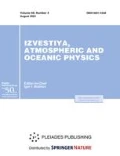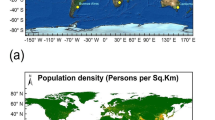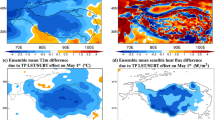Abstract—
Using the example of an analysis of an extreme lowering of temperature in Moscow in January 2017, the horizontal and vertical extent of the urban heat island against the background of a strong stable stratification of the atmospheric boundary layer is studied. The possibilities of measuring and monitoring the vertical structure of the atmosphere using ground-based remote sensing are investigated. The capabilities of the mesoscale model WRF, adapted for a detailed description of mixing processes in the atmospheric boundary layer, in reproducing the spatial dynamics of the temperature anomaly are demonstrated. The numerical estimates of the amplitude and vertical extent of the urban heat island are compared with the measurement accuracy and the total errors of the numerical predictions. A comparison of measurement data and numerical simulation results on the WRF model, using the example of a winter urban heat island in January 2017, showed that mesoscale synoptic models so far only capture the main features of the urban heat island. However, deviations between model and observed temperature fields can reach 5°C.










Similar content being viewed by others
REFERENCES
J. Y. Han, J. J. Baik, and H. Lee, “Urban impacts on precipitation,” Asia-Pacific J. Atmos. Sci 50 (1), 17–30 (2014).
J. Hidalgo, G. Pigeon, and V. Masson, “Urban-breeze circulation during the CAPITOUL experiment: Observational data analysis approach,” Meteorol. Atmos. Phys. 102 (3–4), 223–241 (2008).
A. Lemonsu and V. Masson, “Simulation of a summer urban breeze over Paris,” Boundary-Layer Meteorol. 104 (3), 463–490 (2002).
J. M. Shepherd, “A review of current investigations of urban-induced rainfall and recommendations for the future,” Earth Interact. 9 (12), 1–27 (2005).
M. A. Lokoshchenko and I. A. Korneva, “Underground urban heat island below Moscow city,” Urban Clim. 13, 1–13 (2015).
S. A. Benz, P. Bayer, F. M. Goettsche, F. S. Olesen, and P. Blum, “Linking surface urban heat islands with groundwater temperatures,” Environ. Sci. Technol. 50 (1), 70–78 (2016).
A. J. Elmore, S. M. Guinn, B. J. Minsley, and A. D. Richardson, “Landscape controls on the timing of spring, autumn, and growing season length in mid-Atlantic forests,” Global Change Biol. 18 (2), 656–674 (2012).
I. Esau, V. V. Miles, R. Davy, M. W. Miles, and A. Kurchatova, “Trends in normalized difference vegetation index (NDVI) associated with urban development in northern West Siberia,” Atmos. Chem. Phys. 16 (15), 9563–9577 (2016).
D. Zhou, S. Zhao, L. Zhang, G. Sun, and Y. Liu, “The footprint of urban heat island effect in China,” Sci. Rep. 5, 2–12 (2015).
M. B. Dillon, M. S. Lamanna, G. W. Schade, A. H. Goldstein, and R. C. Cohen, “Chemical evolution of the Sacramento urban plume: Transport and oxidation,” J. Geophys. Res. 107 (D5), 206 (2002).
T. L. Mote, M. C. Lacke, and J. M. Shepherd, “Radar signatures of the urban effect on precipitation distribution: A case study for Atlanta, Georgia,” Geophys. Res. Lett. 34 (20), 2–5 (2007).
T. R. Oke, G. Mills, A. Christen, and J. A. Voogt, Urban Climates (Cambridge University Press, Cambridge, 2017).
A. J. Arnfield, “Two decades of urban climate research: A review of turbulence, exchanges of energy and water, and the urban heat island,” Int. J. Climatol. 23 (1), 1–26 (2003).
C. S. B. Grimmond, “Progress in measuring and observing the urban atmosphere,” Theor. Appl. Climatol. 84 (1–3), 3–22 (2006).
A. Tzavali, J. P. Paravantis, G. Mihalakakou, A. Fotiadi, and E. Stigka, “Urban heat island intensity: A literature review,” Fresenius Environ. Bull. 24, 4535–4554 (2015).
T. R. Oke, “The energetic basis of the urban heat island,” Q. J. R. Meteorol. Soc. 108 (455), 1–24 (1982).
T. R. Oke, A. Spronken-Smith, E. Jauregui, and C. S. B. Grimmond, “The energy balance of central Mexico City during the dry season,” Atmos. Environ. 33, 3919–3930 (1999).
T. W. Hawkins, A. J. Brazel, W. L. Stefanov, W. Bigler, and E. M. Saffell, “The role of rural variability in urban heat island determination for Phoenix, Arizona,” J. Appl. Meteorol. 43, 476– 486 (2004).
J. D. Fast, J. C. Torcolini, and R. Redman, “Vertical temperature profiles and the urban heat island measured by a temperature datalogger network in Phoenix, Arizona,” J. Appl. Meteorol. 44, 3–13 (2005).
C. J. G. Morris, I. Simmonds, and N. Plummer, “Quantification of the influences of wind and cloud on the nocturnal urban heat island of a large city,” J. Appl. Meteorol. 40, 169–182 (2001).
I. Livada, M. Santamouris, K. Niachou, N. Papanikolaou, and G. Mihalakakou, “Determination of places in the great Athens area where the heat island effect is observed,” Theor. Appl. Climatol. 71, 219–230 (2002).
K. Klysik and K. Fortuniak, “Temporal and spatial characteristics of the urban heat island of Lodz, Poland,” Atmos. Environ. 33, 3885–3895 (1999).
K. M. Hinkel, F. E. Nelson, A. E. Klene, and J. H. Bell, “The urban heat island in winter at Barrow, Alaska,” Int. J. Climatol. 23 (15), 1889–1905 (2003).
N. F. Elansky, O. V. Lavrova, I. I. Mokhov, and A. A. Rakin, “Heat island structure over Russian towns based on mobile laboratory observations,” Dokl. Earth Sci. 443 (1), 420–425 (2012).
A. M. Rizwan, L. Y. Dennis, and L. I. U. Chunho, “A review on the generation, determination and mitigation of urban heat island,” J. Environ. Sci. 20 (1), 120–128 (2008).
G. I. Gorchakov, E. N. Kadygrov, V. E. Kunitsyn, V. I. Zakharov, E. G. Semutnikova, A. V. Karpov, G. A. Kurbatov, E. A. Miller, and S. I. Sitanskii, “The Moscow heat island in the blocking anticyclone during summer 2010,” Dokl. Earth Sci. 456 (2), 736–740 (2014).
B. A. Revich, “Heat waves, atmospheric air quality and the mortality of the population of the European part of Russia in summer 2010: Preliminary assessment results,” Ekol. Chel., No. 7, 3–9 (2011).
V. V. Vinogradova, “Heat waves in the European Russia at the beginning of the 21st century,” Izv. Ross. Akad. Nauk: Ser. Geogr., No. 1, 47–55 (2014).
M. I. Varentsov, P. I. Konstantinov, T. E. Samsonov, and I. A. Repina, “Investigation of the urban heat island phenomenon during the polar night with experimental measurements and remote sensing for Norilsk city,” Sovrem. Probl. Distantsionnogo Zondirovaniya Zemli Kosmosa 11 (4), 329–337 (2014).
K. M. Hinkel and F. E. Nelson, “Anthropogenic heat island at Barrow, Alaska, during winter: 2001–2005,” J. Geophys. Res.: Atmos. 112 (6), 2001–2005 (2007).
N. Magee, J. Curtis, and G. Wendler, “The urban heat island effect at Fairbanks, Alaska,” Theor. Appl. Climatol. 64 (1–2), 39–47 (1999).
P. I. Konstantinov, M. Yu. Grishchenko, and M. I. Varentsov, “Mapping urban heat islands of arctic cities using combined data on field measurements and satellite images based on the example of the city of Apatity (Murmansk Oblast),” Izv., Atmos. Ocean. Phys. 51 (9), 992–998 (2015).
P. Konstantinov, M. Varentsov, and I. Esau, “A high density urban temperature network deployed in several cities of Eurasian Arctic,” Environ. Res. Lett. 13 (7) (2018).
M. Varentsov, P. Konstantinov, A. Baklanov, I. Esau, V. Miles V., and R. Davy, “Anthropogenic and natural drivers of a strong winter urban heat island in a typical Arctic city,” Atmos. Chem. Phys. 18, 17573–17587 (2018).
T. Nygård, T. Valkonen, and T. Vihma, “Characteristics of Arctic low-tropospheric humidity inversions based on radio soundings,” Atmos. Chem. Phys. 14 (4), 1959–1971 (2014).
C. Wetzel and B. Brümmer, “An Arctic inversion climatology based on the European Centre Reanalysis ERA-40,” Meteorol. Z. 20 (6), 589–600 (2011).
E. Atlaskin and T. Vihma, “Evaluation of NWP Results for wintertime nocturnal boundary-layer temperatures over Europe and Finland,” Q. J. R. Meteorol. Soc. 138 (667), 1440–1451 (2012).
W. Anderson, Q. Li, and E. Bou-Zeid, “Numerical simulation of flow over urban-like topographies and evaluation of turbulence temporal attributes,” J. Turbul. 16 (9), 809–831 (2015).
J. Sadique, X. I. A. Yang, C. Meneveau, and R. Mittal, “Aerodynamic properties of rough surfaces with high aspect-ratio roughness elements: Effect of aspect ratio and arrangements,” Boundary Layer Meteorol. 163 (2), 203–224 (2017).
X. X. Li, R. Britter, and L. K. Norford, “Effect of stable stratification on dispersion within urban street canyons: A large-eddy simulation,” Atmos. Environ. 144, 47–59 (2016).
A. V. Glazunov, “Numerical simulation of stably stratified turbulent flows over an urban surface: Spectra and scales and parameterization of temperature and wind-velocity profiles,” Izv., Atmos. Ocean. Phys. 50 (4), 356–368 (2014).
A. V. Glazunov, “Numerical simulation of stably stratified turbulent flows over flat and urban surfaces,” Izv., Atmos. Ocean. Phys. 50 (3), 236–246 (2014).
M. Varentsov, H. Wouters, V. Platonov, and P. Konstantinov, “Megacity-induced mesoclimatic effects in the lower atmosphere: A modeling study for multiple summers over Moscow, Russia,” Atmosphere (Basel) 9 (2), 50 (2018).
K. Trusilova, S. Schubert, H. Wouters, B. Früh, S. Grossman-Clarke, M. Demuzere, and P. Becker, “The urban land use in the COSMO-CLM model: a comparison of three parameterizations for Berlin,” Meteorol. Z. 25 (2), 231–244 (2016).
F. Salamanca, A. Martilli, M. Tewari, and F. Chen, “A study of the urban boundary layer using different urban parameterizations and high-resolution urban canopy parameters with WRF,” J. Appl. Meteorol. Climatol. 50 (5), 1107–1128 (2011).
A. Baklanov, P. G. Mestayer, A. Clappier, S. Zilitinkevich, S. Joffre, A. Mahura, and N. W. Nielsen, “Towards improving the simulation of meteorological fields in urban areas through updated/advanced surface fluxes description,” Atmos. Chem. Phys. 8 (3), 523–543 (2008).
Meteorological temperature profiler MTP-5. http://attex.net/RU/mtp5.php.
V. P. Yushkov, “Remote sounding and mesoscale synoptic models in studying the urban boundary layer,” Atmos. Oceanic Opt. 30 (5), 462–474 (2017).
E. N. Kadygrov, I. N. Kuznetsova, and G. S. Golitsyn, “Heat island in the boundary atmospheric layer over a large city: New results based on remote sensing data,” Dokl. Earth Sci. 385 (6), 688–694 (2002).
I. N. Kuznetsova, E. N. Kadygrov, E. A. Miller, and M. I. Nakhaev, “Characteristics of the lowest 600 m atmospheric layer temperature on the basis of MTP-5 profiler data,” Opt. Atmos. Okeana. 25 (10), 877–883 (2012).
I. N. Ezau, T. Wolf, E. A. Miller, I. A. Repina, Yu. I. Troitskaya, and S. S. Zilitinkevich, “The analysis of results of remote sensing monitoring of the temperature profile in lower atmosphere in Bergen (Norway),” Russ. Meteorol. Hydrol. 38 (10), 715–722 (2013).
A. V. Troitskii, “Remote determination of atmospheric temperature from spectral radiometric measurements in the λ = 5-mm line,” Radiophys. Quantum Electron. 29 (8), 670–678 (1986).
The Weather Research and Forecasting Model. http://www.wrf-model.org.
J. Michalakes, J. Dudhia, D. Gill, T. Henderson, J. Klemp, W. Skamarock, and W. Wang, “The Weather Research and Forecast Model: Software architecture and performance,” in Use of High Performance Computing in Meteorology, Proceedings of the Eleventh ECMWF Workshop, Reading, UK, 25–29 October 2004, Ed. by W. Zwieflhofer and G. Mozdzynski (World Scientific, 2005), pp. 156–168.
W. C. Skamarock, J. B. Klemp, J. Dudhia, D. O. Gill, D. M. Barker, M. G. Duda, X. Y. Huang, W. Wang, and J. G. Powers, A description of the advanced research WRF Version 3, NCAR Technical Note, Boulder, Colorado: National Center for Atmospheric Research, Mesoscale and Microscale Meteorology Division, 2008.
Global Forecast System. http://www.emc.ncep.noaa. gov/GFS/doc.php.
G. Thompson, R. M. Rasmussen, and K. Manning, “Explicit forecasts of winter precipitation using an improved bulk microphysics scheme. Part I: Description and sensitivity analysis,” Mon. Weather Rev. 132 (2), 519–542 (2004).
M. J. Iacono, J. S. Delamere, E. J. Mlawer, M. W. Shephard, S. A. Clough, and W. D. Collins, “Radiative forcing by long-lived greenhouse gases: Calculations with the AER radiative transfer models,” J. Geophys. Res.: Atmos. 113 (D13) (2008).
M. Tewari, F. Chen, W. Wang, J. Dudhia, M. A. LeMone, K. Mitchell, M. Ek, G. Gayno, J. Wegiel, and R. H. Cuenca, “Implementation and verification of the unified NOAH land surface model in the WRF model,” in 20th Conference on Weather Analysis and Forecasting/16th Conference on Numerical Weather Prediction (2004), Vol. 1115, pp. 11–15.
G. A. Grell and D. Dévényi, “A generalized approach to parameterizing convection combining ensemble and data assimilation techniques,” Geophys. Res. Lett. 29 (14), 38-1–38-4 (2002).
P. Bougeault and P. Lacarrere, “Parameterization of orography-induced turbulence in a mesobeta-scale model,” Mon. Weather Rev. 117 (8), 1872–1890 (1989).
F. Chen, H. Kusaka, R. Bornstein, J. Ching, C. S. B. Grimmond, S. Grossman-Clarke, T. Loridan, K. W. Manning, A. Martilli, S. Miao, and D. Sailor, “The integrated WRF/urban modelling system: Development, evaluation, and applications to urban environmental problems,” Int. J. Climatol. 31 (2), 273–288 (2011).
I. D. Stewart and T. R. Oke, “Local climate zones for urban temperature studies,” Bull. Am. Meteorol. Soc. 93 (12), 1879–1900 (2012).
B. P. Shekhtman, The Moscow Climate: Specific Features of Climate in a Megacity) (Gidrometeoizdat, Moscow, 1969) [in Russian].
S. Argentini, G. Mastrantonio, and F. Lena, “Case studies of the wintertime convective boundary-layer structure in the urban area of Milan, Italy,” Boundary Layer Meteorol. 93 (2), 253–267 (1999).
J. J. Baik, Y. H. Kim, and H. Y. Chun, “Dry and moist convection forced by an urban heat island,” J. Appl. Meteorol. 40 (8), 1462–1475 (2001).
M. M. Smirnova, K. G. Rubinshtein, and V. P. Yushkov, “Evaluation of atmospheric boundary layer characteristics simulated by the regional model,” Russ. Meteorol. Hydrol. 36 (12), 777–785 (2011).
V. P. Yushkov, M. A. Kallistratova, R. D. Kouznetsov, G. A. Kurbatov, and V. F. Kramar, “Experience in measuring the wind-velocity profile in an urban environment with a Doppler sodar,” Izv., Atmos. Ocean. Phys. 43 (2), 168–180 (2007).
ACKNOWLEDGMENTS
We are grateful to D.D. Kuznetsov and V.S. Lyulyukin for providing the observational data.
Funding
This work was supported by the Russian Foundation for Basic Research, projects nos. 18-08-00074, 19-05-00028 and 18-05-60126.
The work of M. Varentsov on the analysis of the spatial structure of the heat island according to surface observations was supported by the Russian Science Foundation, project no. 17-77-20070.
Author information
Authors and Affiliations
Corresponding author
Additional information
Translated by V. Selikhanovich
Rights and permissions
About this article
Cite this article
Yushkov, V.P., Kurbatova, M.M., Varentsov, M.I. et al. Modeling an Urban Heat Island during Extreme Frost in Moscow in January 2017. Izv. Atmos. Ocean. Phys. 55, 389–406 (2019). https://doi.org/10.1134/S0001433819050128
Received:
Revised:
Accepted:
Published:
Issue Date:
DOI: https://doi.org/10.1134/S0001433819050128




